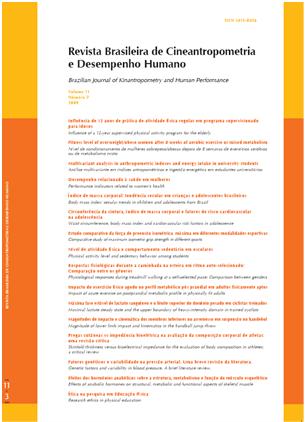Magnitude of lower limb impact and kinematics in the handball jump throw
DOI:
https://doi.org/10.1590/1980-0037.2009v11n3p326Abstract
The purpose of this study was to investigate kinematic characteristics and impact of the handball jump throw. Nine male athletes of the university team participated of this study. A tri-axial accelerometer was used for identify the impact magnitude of the lower limb and the three-dimensional analysis system DMAS 5.0® was used for the analysis knee and hip angle of the jump throw. The kinematic and accelerometry dates were simultaneously collection. Reflective markers were placed on the anatomic landmarks of the athletes and the accelerometer was placed on the knee and ankle. For the date analyses, descriptive statistics, analysis of variance and Pearson correlate were used. The level of significance was set at 5% for all tests. The biggest impact magnitudes were acquired of the anterior-posterior axle on the ankle joint (58.81 g). Knee and hip angle in the contact with ground were lesser than knee and hip angle in the maximum flexion of the lower limb (27.24º and 33.75º for knee and 25.77º and 26.77º for hip), respectively. The impact magnitude in the knee of the anterior-posterior axle showed inverse correlate with the knee (r= -0.64; p= 0.05) and hip angle (r= -0.77; p= 0.01) in contact with ground. From results can be conclude that, although this team to be amateur, is necessary improvement of jump throw technique to decrease of cumulative effects of overload by long time of training.



